
Alfred William Alcock was a British physician, naturalist, and carcinologist.
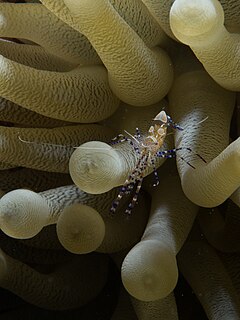
The spotted cleaner shrimp, is a kind of cleaner shrimp common to the Caribbean Sea. These shrimp live among the tentacles of several species of sea anemones. They sway their body and wave their antennae in order to attract fish from which they eat dead tissue, algae and parasites.
Johannes Govertus de Man, was a Dutch biologist. He was assistant curator at the Rijksmuseum van Natuurlijke Historie in Leiden, where he specialised in free-living nematodes and decapod crustaceans, although he also wrote papers on flatworms, sipunculids and, in his dissertation only, vertebrates. His change away from vertebrates disappointed the director of the museum, and de Man left his job there after eleven years. For the rest of his life, de Man worked at his parents' house in Middelburg and later at a house near the shore at Yerseke in the Oosterschelde estuary, relying on his family's private income.

Cuspidariidae is a family of small marine bivalve molluscs in the superfamily Cuspidarioidea.
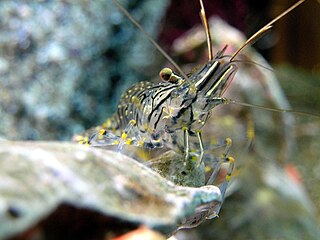
Palaemonoidea is a large superfamily of shrimp, containing nearly 1,000 species. The position of the family Typhlocarididae is unclear, although the monophyly of a group containing the remaining seven families is well supported.
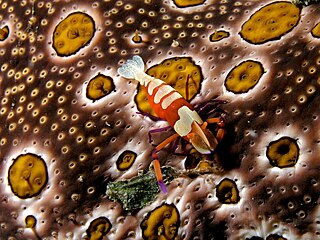
Periclimenes imperator, known as the emperor shrimp, is a species of shrimp with a wide distribution across the Indo-Pacific. It lives commensally on a number of hosts, including the sea slug Hexabranchus. A. J. Bruce first described it in 1967 based on eight specimens ranging from 4 millimetres (0.16 in) to 7.6 millimetres (0.30 in), and found Periclimenes rex to be its best resemblance.

Periclimenes amethysteus is a species of shrimp found in the Adriatic and Aegean Sea, and the western Mediterranean Sea. It was first named by Antoine Risso in 1827.
Periclimenes aegylios is a species of shrimp found in the Adriatic Sea and the western Mediterranean Sea. It was first named by Grippa and d'Udekem d'Acoz in 1996.
Periclimenes dardanicola is a species of shrimp found in the western Pacific Ocean. It lives in association with sea anemones that live on the gastropod shells carried by hermit crabs. It was first named by Alexander J. Bruce and Junji Okuno in 2006. It is mainly white, and grows up to a carapace length of 4 mm (0.16 in).
Cuapetes agag is a species of shrimp found in New Caledonia, Melanesia, Queensland, and the Red Sea. It was first named by Kemp in 1922.
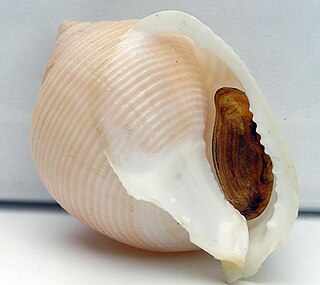
Galeodea is a genus of large sea snails, marine gastropod mollusks in the subfamily Cassinae of the family Cassidae.

Ancylomenes pedersoni, sometimes known as Pederson's shrimp and Pederson's cleaner shrimp, is a species of cleaner shrimp. It is part of the genus Ancylomenes and was described in 1958 by Fenner A. Chace Jr. as Periclimenes pedersoni. Ancylomenes pedersoni is found in the Caribbean Sea, often associated with a sea anemone, at depths of 1 to 15 metres. They are often found on the reefs off Bermuda.
Acromycter alcocki is an eel in the family Congridae. It was described by Charles Henry Gilbert and Frank Cramer in 1897, originally under the genus Promyllantor. It is a marine, deep water-dwelling eel which is known from Hawaii, in the eastern central Pacific Ocean. It dwells at a depth range of 388–640 metres. Males can reach a maximum total length of 25.3 centimetres.
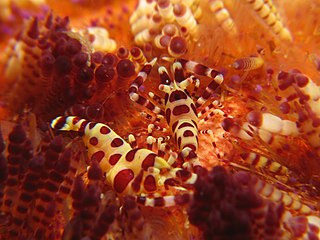
Periclimenes colemani is a species of saltwater shrimp found in the Indo-Pacific Ocean that was first described in 1975.

Dendrophyllia is a genus of stony cup corals in the family Dendrophylliidae. Members of this genus are found at depths down to about 900 metres (3,000 ft). They are azooxanthellate corals, meaning that they do not contain symbiotic photosynthetic dinoflagellates as do many species of coral.

Tubuca alcocki is a species of fiddler crab. Its range includes most of the northern Indian Ocean, from western Thailand, through the Bay of Bengal and India, to the Red Sea.
Sabellaria alcocki is a species of bristle worm described by Charles Joseph Gravier in 1906 and named in honour of Alfred William Alcock.
Sabellaria spinulosa and S. alcocki are smaller than S. alveolata and inhabit the subtidal and lower intertidal/sublittoral fringes. Sabellaria spinulosa has been described from the North Sea and S. alcocki from the Indian Ocean.

Periclimenes, commonly known as glass shrimp or cleaner shrimp, is a commensal and often symbiotic genus of semi-transparent shrimp within the family Palaemonidae. Species of this large genus feature a wide variety of coloration and patterns, widespread distribution throughout much of the world's tropical oceans, and are often sought out for aquarium trade.

Zenopontonia is a genus of shrimp within the family Palaemonidae.












